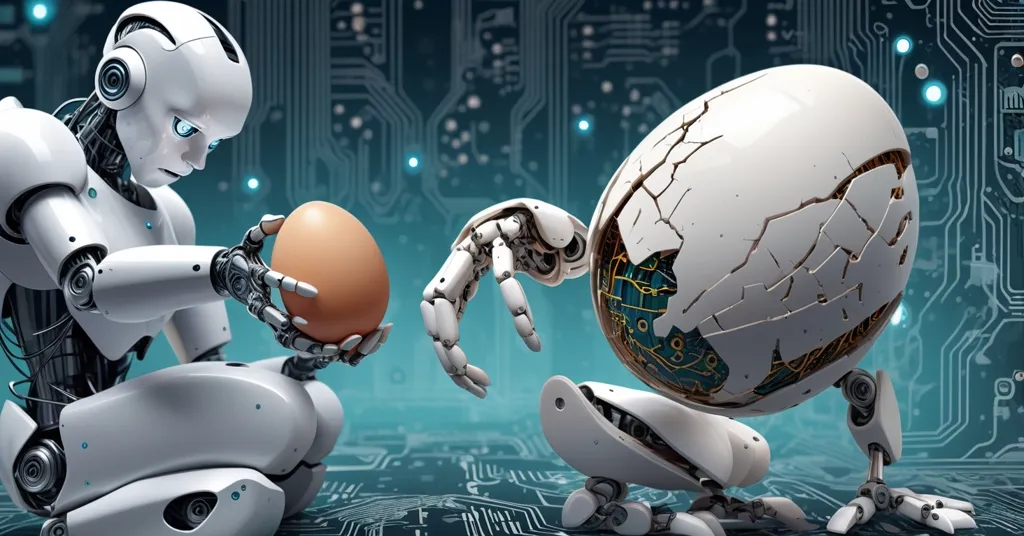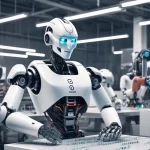Humanoid Robotics Hype: Tech Barriers and Investment Risks Exposed

Humanoid Robotics Hype: Investment Risks and Challenges in a Tech Frenzy
Billions are flooding into humanoid robotics, fueled by dreams of machines that walk, talk, and work like us. Yet, industry heavyweights like Rodney Brooks, co-founder of iRobot, and savvy investor Chris Camillo are sounding the alarm: this gold rush is built on quicksand, not science. Let’s unpack the unrealistic assumptions, technical roadblocks, and deployment nightmares that could keep this sci-fi fantasy grounded for decades.
- Flawed Foundations: Investments hinge on unrealistic ideas about robots mastering human-like dexterity.
- Hardware Hurdles: Current tech can’t replicate human touch, a massive barrier to real-world use.
- Decades-Long Delay: Even with breakthroughs, integration into industries may take 10-15 years.
Technical Roadblocks: Why Robots Can’t Feel Like Us
Rodney Brooks isn’t just another voice in the robotics world—he’s a titan who’s shaped it as co-founder of iRobot, the company behind the Roomba, and a former MIT researcher. With decades of experience, his latest critique of the humanoid robotics mania, as highlighted by renowned researchers questioning flawed investment assumptions, cuts deep. Companies like Tesla, with their Optimus bot, and Figure are banking on video-based learning to teach robots human-like dexterity—think watching a clip of someone folding a shirt and mimicking it. Brooks calls this pure fantasy. Human hands aren’t just tools; they’re marvels of biology with thousands of touch receptors sensing pressure, vibration, and even the slightest slip of an object. Picture a robot trying to cradle a fragile egg—without that tactile feedback, it’s more likely to crush it than carry it. Current robotic hardware for touch sensing is laughably basic, and the algorithms to process such data are barely a sketch. Unlike vision or speech, where AI has thrived on massive datasets and robust infrastructure, there’s no equivalent framework for touch in robotics. It’s like trying to stream 4K video on dial-up internet—good luck with that.
Brooks doesn’t stop there. He points to historical overpromises in the field, noting that even cutting-edge projects like Boston Dynamics’ Atlas, often hyped for its acrobatic flips, struggle with fine motor tasks as simple as picking up a pen without snapping it. The gap between flashy demo reels and practical application is a chasm, and investors seem blind to it. If we’re betting on robots to replace baristas or assemblers anytime soon, we’re in for disappointment. The science just isn’t there, and no amount of venture capital can speed up the laws of physics.
Safety and Practicality: A Dangerous Design Flaw
Beyond the touch barrier, safety is a glaring issue that Brooks hammers home. Humanoid robots—especially larger ones—aren’t just clunky; they’re outright hazardous. Here’s the brutal math: when a robot doubles in height, its weight doesn’t just double—it balloons far faster than its frame can support, making a fall potentially catastrophic. Imagine a six-foot robot toppling over in your kitchen; it’s not a minor mishap, it’s a wrecking ball. Current designs aren’t certified for close human interaction, and they likely won’t be for years. Then there’s the energy drain. Bipedal movement—walking on two legs like us—guzzles power compared to, say, rolling on wheels. It’s not just inefficient; it’s structurally unstable for dynamic environments like homes or crowded warehouses.
Brooks isn’t buying the Hollywood vision of androids strolling among us. Sorry, folks, but C-3PO isn’t showing up to fold your laundry anytime soon. Instead, he predicts the robots that will dominate over the next 15 years will ditch the human form entirely. Think machines with wheels for efficient mobility, multiple arms for versatility, and specialized sensors built for specific jobs. Practicality trumps pageantry, and Brooks bets the industry will pivot to designs that actually work rather than ones that merely dazzle. So why are investors still chasing bipedal dreams? It’s a question of optics over outcomes, and it’s a gamble that could crash hard.
Deployment Nightmares: The Real Bottleneck
Even if we solve the tech puzzles, the road to mass adoption is a logistical quagmire. Enter Chris Camillo, an investor who turned a modest $20,000 into a staggering $60 million through robotics bets, backed by over 400 hours of research. While he’s bullish on the long-term vision, his near-term outlook is sobering. The bottleneck isn’t manufacturing—it’s integration. Picture rolling out a fleet of generalized robots into a Walmart warehouse or a FedEx sorting hub. It’s not enough for the robot to function; entire systems need overhauling. This means updating ancient warehouse databases so robots can read and interact with them, training workers to collaborate with machines, and redesigning workflows to handle robotic quirks. Even something as mundane as ensuring a robot can navigate the chaotic packaging at a Coca-Cola distribution center turns into a multi-year, multi-million-dollar headache.
Most people I speak to that are deeply engaged with this space, we all agree on one thing: at the point where we actually have a scalable humanoid robotics platform, fully scalable that has met all the KPI thresholds… we will start a 10–15 year supply-demand imbalance, where it doesn’t matter how much you can manufacture.
Camillo’s words are a gut punch to short-term optimists. A decade or more before humanoid robots become commonplace isn’t just a delay; it’s a reality check. Take Amazon’s warehouses as an example—robots might stack boxes, but adapting to last-minute order changes or seasonal chaos? That’s a horizon far beyond the next earnings call. The world isn’t ready to absorb these machines at scale, no matter how fast factories churn them out. It’s a stark reminder that hardware breakthroughs are only half the battle; the other half is grinding, unglamorous system integration.
The Other Side: Why Some Still Bet Big
Despite the skepticism, it’s worth noting why some investors remain all-in on humanoid robotics. Beyond Tesla’s brand power with projects like Optimus, there are tangible drivers fueling optimism. Advances in AI, particularly in machine learning models for vision and motion, have shown promise in simplifying robotic training, even if touch remains elusive. Government funding in automation—especially in aging economies like Japan or labor-strapped regions in Europe—adds another layer of support. Plus, the potential to address global labor shortages, from caregiving to manufacturing, keeps the dream alive. But here’s the rub: these tailwinds don’t erase the fundamental flaws Brooks and Camillo highlight. Just as the 2017 ICO bubble in crypto promised instant riches only to collapse under scrutiny, robotics risks a similar fate if hype outpaces hard deliverables. Optimism is fine; blind faith is a fool’s errand.
Blockchain and Robotics: A Decentralized Future?
Now, let’s tie this to a terrain more familiar to our readers: decentralized tech. Robotics, much like cryptocurrency, sits at the crossroads of revolutionary potential and brutal roadblocks. Just as Bitcoin upended centralized banking, blockchain could decentralize robotic control, cutting reliance on single-point failure systems. Imagine IoT networks on blockchain, securely coordinating robot fleets in real-time without a vulnerable central server. Or consider smart contracts automating maintenance schedules—think a robot self-reporting wear-and-tear on a tamper-proof ledger, triggering repair orders without human middlemen. Even robot identity could mirror NFTs, assigning unique, verifiable IDs to machines in sprawling industrial ecosystems. These intersections are still theoretical, but they highlight a shared ethos: freedom from gatekeepers, whether in finance or automation.
Yet, much like early Bitcoin struggled with scalability, blockchain’s role in robotics faces hurdles. Latency in decentralized networks could cripple real-time robotic tasks, and energy costs—already a pain point for bipedal bots—could spike with blockchain’s computational demands. It’s a promising overlap, but not a silver bullet. The immediate focus for robotics must remain on nuts-and-bolts challenges, not speculative synergies. Still, for crypto enthusiasts eyeing the next frontier, this is a space to watch. Disruption often comes from unexpected pairings, and robotics plus decentralization could be one such spark—if we survive the current mania without imploding.
Lessons from Crypto: Patience Over Promises
Humanoid robotics, much like early crypto, is a field where sky-high promises collide with gritty realities. Bitcoin took years to evolve from a niche experiment to a store of value, weathering scams, crashes, and skepticism along the way. Robotics faces a similar arc, compounded by physical engineering limits that no whitepaper can wish away. Brooks and Camillo aren’t doomsayers; they’re realists urging a pivot from flashy demos to functional grit. Investors ignoring their warnings risk repeating crypto’s worst mistakes—think 2017 altcoin shills peddling vaporware. The future of robotics is coming, no doubt, but not on a Hollywood timeline. Patience and pragmatism will outlast blind frenzy, whether you’re hodling BTC or betting on bots. For now, the message is clear: this is a long game, and anyone chasing quick wins is in for a rude awakening.
Key Takeaways and Questions on Humanoid Robotics Challenges
- Are investments in humanoid robots based on solid ground?
Hardly—experts like Rodney Brooks argue they’re driven by overblown assumptions about achieving human-like dexterity, ignoring core technical gaps. - Why can’t robots mimic human touch yet?
They lack advanced touch-sensing hardware and algorithms, and unlike vision or speech tech, there’s no infrastructure to process tactile data effectively. - What are the safety concerns with humanoid robots?
Larger robots pose serious risks in falls due to disproportionate weight scaling, and current designs aren’t safe for close human interaction. - How long until humanoid robots see wide adoption?
Chris Camillo predicts a 10-15 year supply-demand imbalance, as integrating robots into industries requires massive system and workforce overhauls. - What will successful robots likely look like in the future?
Brooks foresees non-humanoid designs with wheels, multiple arms, and specialized sensors, focusing on function over human appearance. - Could blockchain play a role in robotics development?
Potentially—decentralized networks could secure robot coordination or automate tasks via smart contracts, though latency and energy issues remain hurdles.



